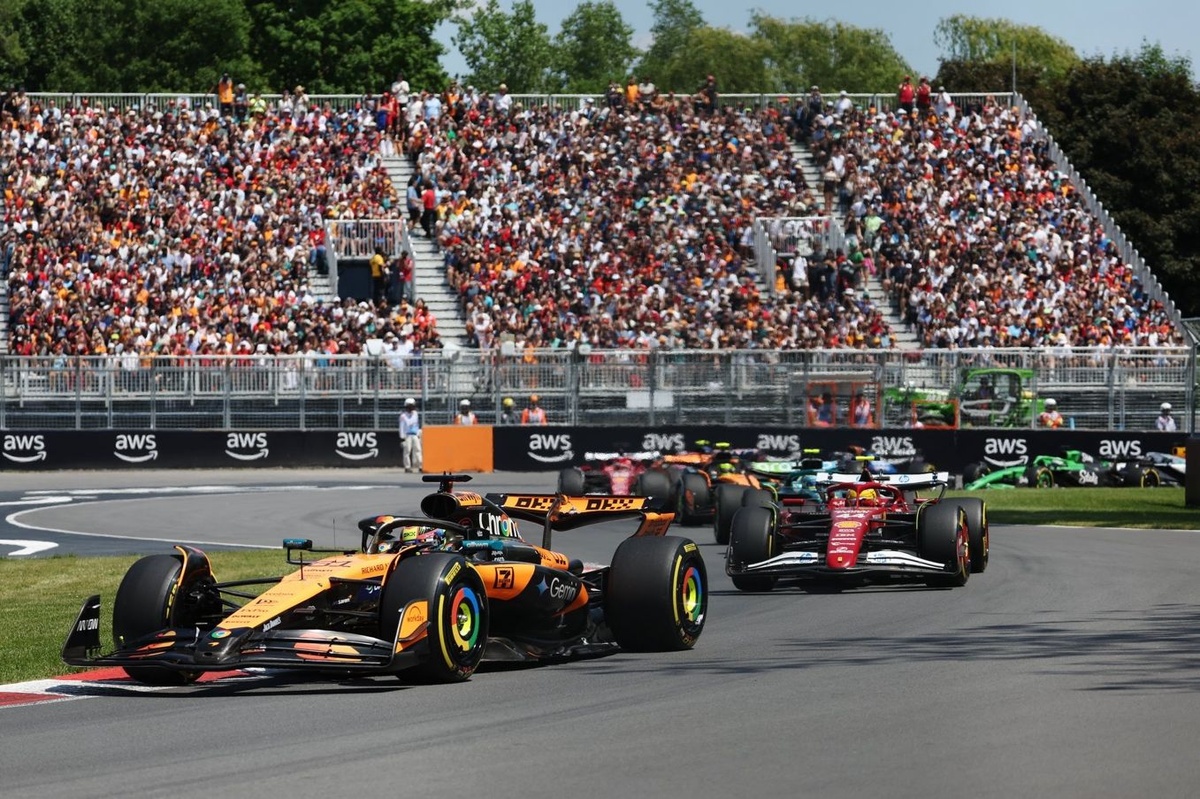In a move the FIA has said will bring more “transparency” to the stewarding practices of Formula 1 race weekends, motorsport’s governing body has made some of its guidelines available to the public for the first time.
Here, Motorsport.com highlights some of the interesting points from the information at hand.
Mohammed Ben Sulayem puts himself front and centre

Mohammed ben Sulayem, FIA President, Nikolas Tombazis, FIA Single Seater Director
Photo by: Rudy Carezzevoli / Motorsport Images
In what is unlikely to come as a shock to most F1 fans, FIA president Mohammed Ben Sulayem could not resist the urge to make the publication of these guidelines about himself.
With the news on Wednesday that Carlos Sainz Sr has opted against standing in the presidential election later this year, it looks seemingly more inevitable that Ben Sulayem will face no competition as he aims to win another term.
His tenure has courted plenty of controversy, including around the swearing guidelines mentioned in the new documents.
Mentioned three times in the article linking to the guidelines, Ben Sulayem also explains why the decision has been made to go public with them, saying that FIA stewards’: “…dedication is all too often met with extreme and wholly unwarranted criticism.
“To demonstrate the rigour with which they pursue their role, we are today publishing the Penalty and Driving Standards Guidelines that assist them with their decisions. This will give fans and members of the media a much deeper and more accurate insight into how decisions are made in Formula 1.”
Other series will follow suit

Start action
Photo by: Emanuele Clivati | AG Photo
The other point of note before even opening either of the documents published by the FIA is that is has also committed to doing the same across the other series it oversees.
“Following the publication of the FIA Formula One World Championship Penalty and Driving Standards Guidelines, parallel documents in the FIA’s six other World Championships are set to be released sequentially, with each set accounting for the regulations and sporting particularities of each championship,” the statement read.
That means fans of the World Endurance Championship, Formula E and the World Rally Championship – among others – will also soon be able to get that “deeper and more accurate insight” into the decision-making process.
Verstappen’s Spanish GP punishment explained

Max Verstappen, Red Bull Racing, George Russell, Mercedes
Photo by: Sam Bloxham / Motorsport Images via Getty Images
Max Verstappen was hit with a 10-place penalty and three points on his superlicence after driving into the Mercedes of George Russell towards the end of the Spanish Grand Prix earlier this month.
It left him teetering on the edge of a race ban, with just more point in either Canada or Austria triggering a suspension for amassing a total of 12 points in a year-long period. Now the FIA penalty guidelines explain why that was the punishment handed down – and how Verstappen escaped an immediate ban.
The stewards in Barcelona deemed that Verstappen had caused: “a collision with no immediate and obvious sporting consequence,” thus he was punished as above – but had the stewards decided the world champion had caused: “a collision with apparent deliberate or reckless intent,” he would have faced a 10-second stop/go penalty and four points on his superlicence, which would have seen the Red Bull driver banned from the Canadian Grand Prix – where instead he finished second, behind Russell.
Show your workings

Lando Norris, McLaren MCL38, battles with Max Verstappen, Red Bull Racing RB20
Photo by: Sam Bagnall / Motorsport Images
A number of the points set out in the driving standards guidelines document have been referenced in recent memory.
The position of a car’s front axle in an overtaking manoeuvre down the inside or around the outside, those are a constant debate during most grand prix weekends – although maybe not Monaco.
Likewise the guidance over track limits and giving back a lasting advantage, but there is some interest in what the document lays out as the “rationale” behind the practices.
These include: “Overtaking should be incentivised and defending a position unfairly or dangerously is not acceptable,” while also explaining the roll out in other formula: “It is very important that junior drivers race with the same guidelines as F1. However, less tolerance should be applied because the risk of an accident is higher due to their lesser experience. Being stricter in applying the rules in lower formulas is essential for junior driver development.”
What Red Bull’s Canadian GP appeal could have meant for Russell

The FIA Safety Car on the field
Photo by: Sam Bloxham / Motorsport Images via Getty Images
After coming to blows on the track in Spain, Russell and Verstappen were again involved in an incident in Montreal. Behind a late-race safety car, Verstappen claimed Russell had braked erratically.
After the race, Red Bull appealed to the stewards, initially citing the aforementioned incident as well as claiming Russell had not stayed within the regulated 10-car lengths of the safety car.
While the manner of its appeal changed over the course of the night, Red Bull’s initial claims could have landed Russell in a heap of trouble had the safety car infringements been upheld.
“Driving unnecessarily slowly, erratically or in a manner which could be deemed potentially dangerous to other drivers or any other person whilst the safety car is deployed,” can earn a driver a five or 10-second penalty or a drive-through or 10-second stop and go penalty, as well as up to four points on their licence.
Meanwhile, “Failing to keep within 10 cars lengths of the SC” carries up to three penalty points and five or 10-second or drive-though, penalty. Russell will be pleased he was able to show he was guilty of none of those charges and could celebrate his first win of the season as a result.
In this article
Mark Mann-Bryans
Formula 1
Be the first to know and subscribe for real-time news email updates on these topics
Subscribe to news alerts






